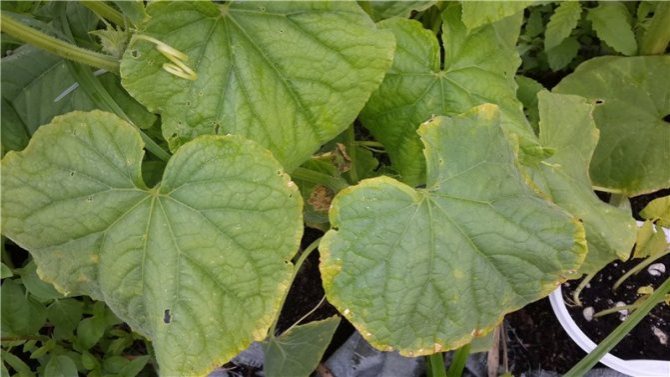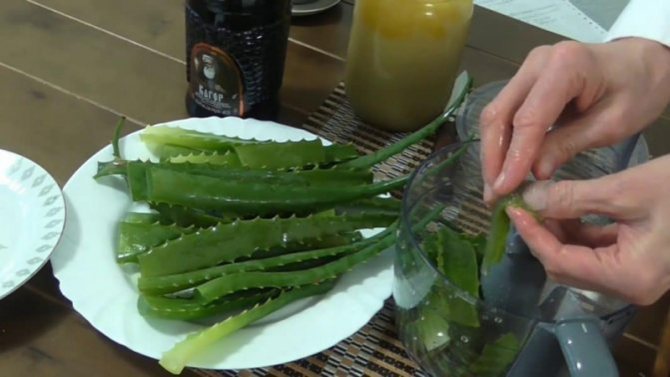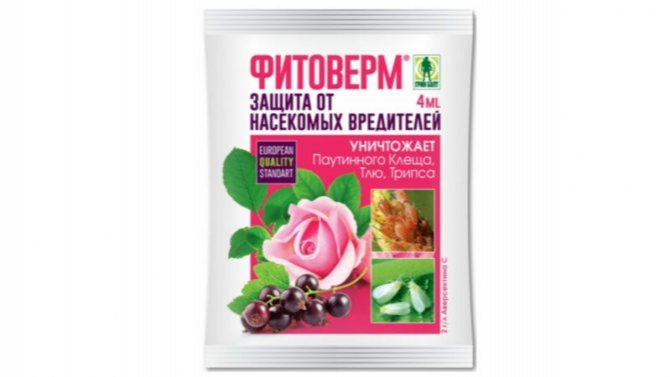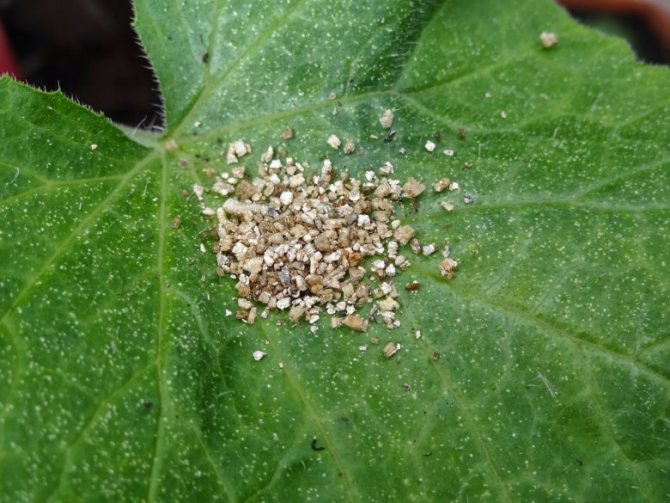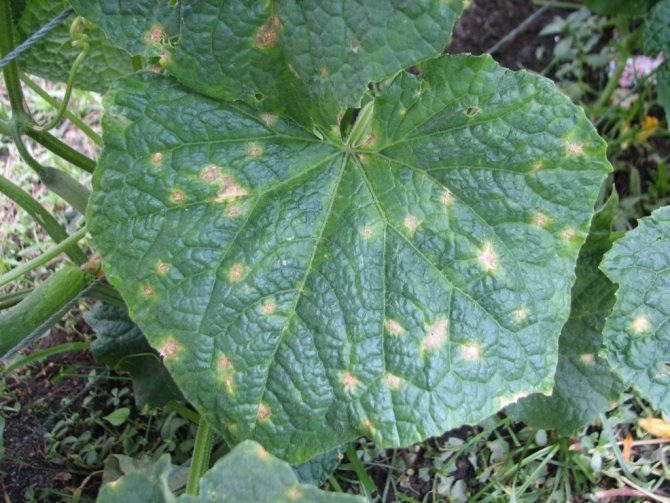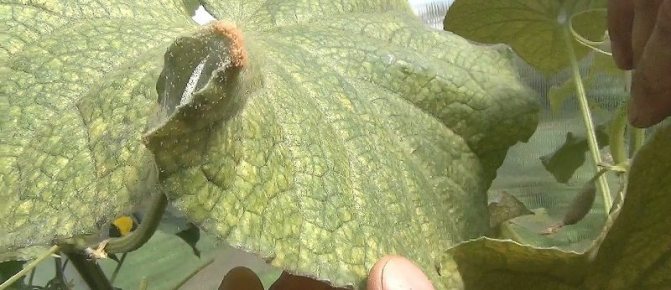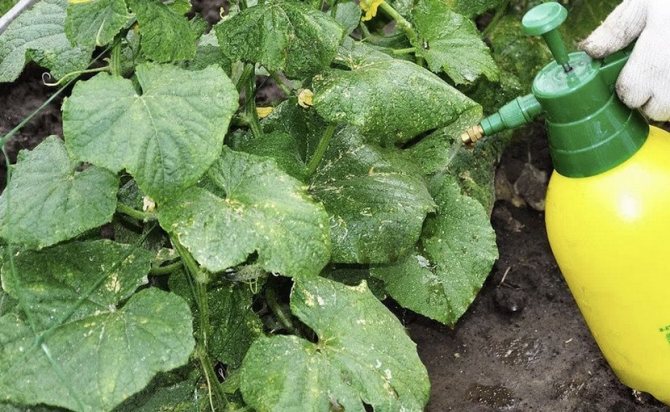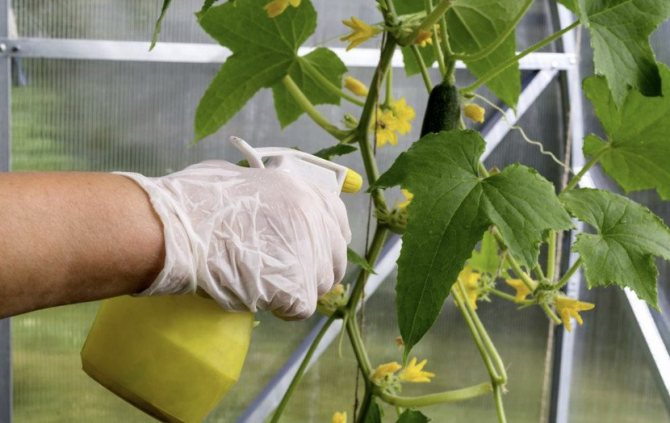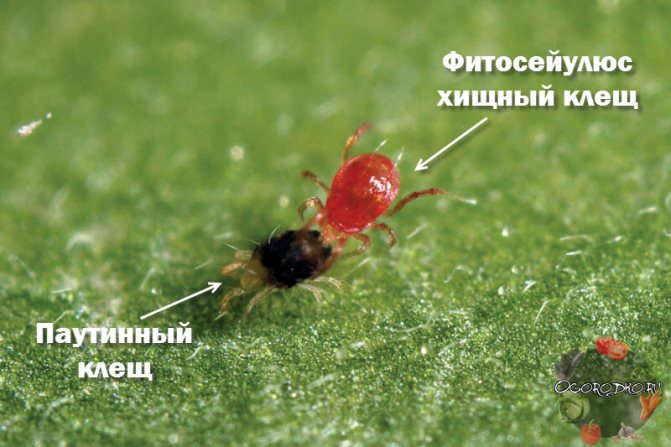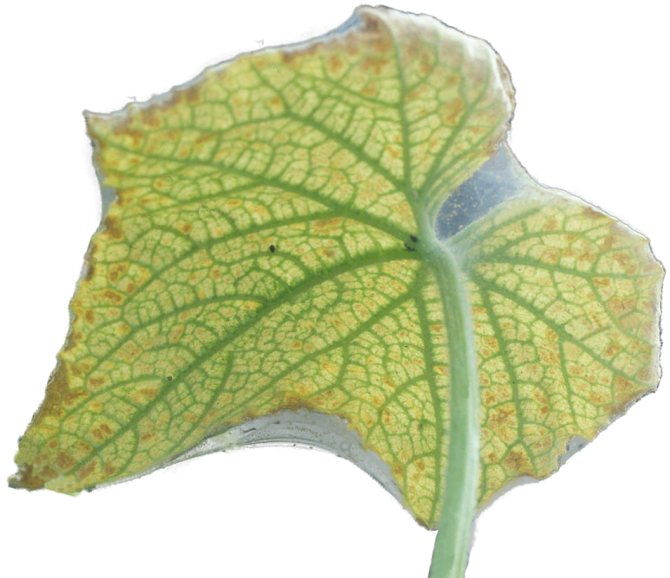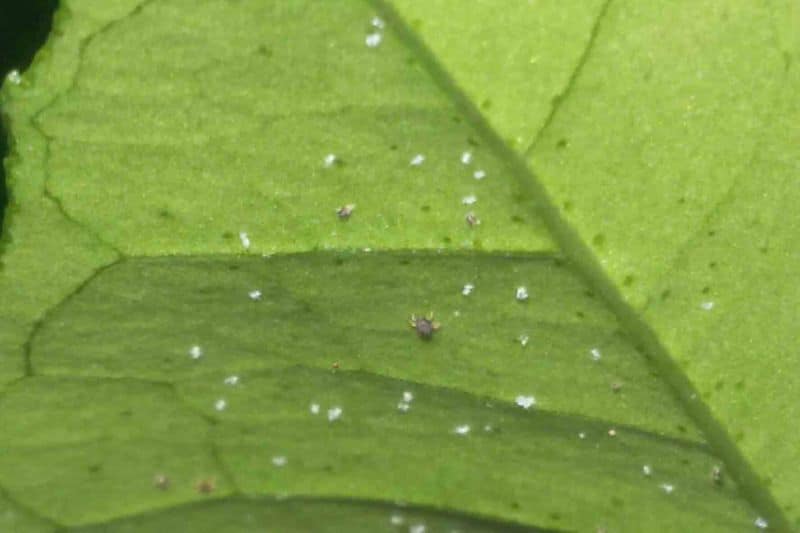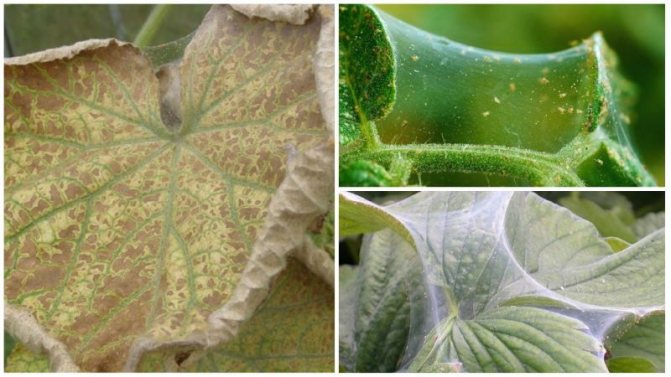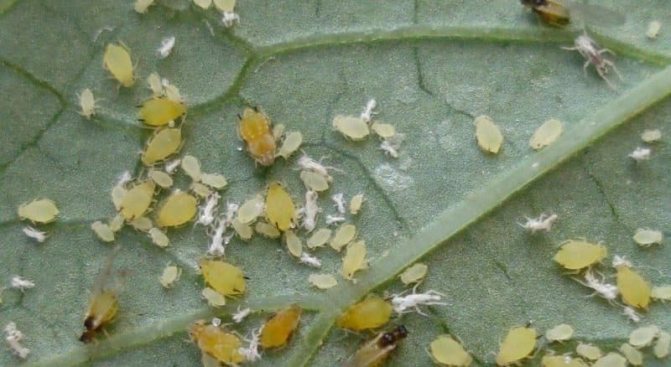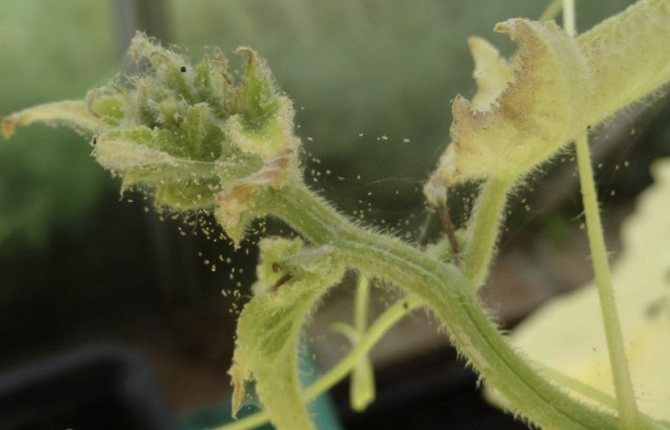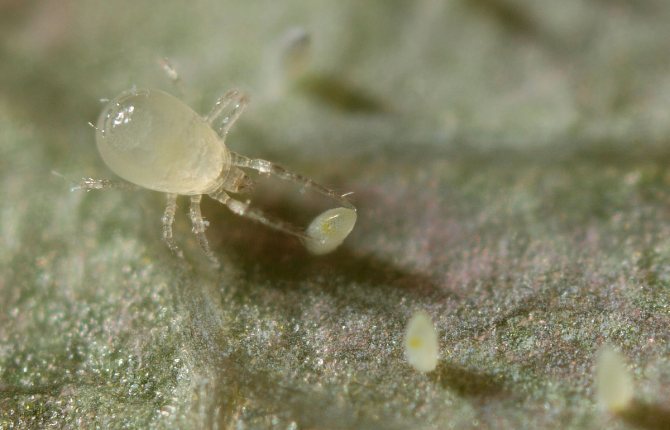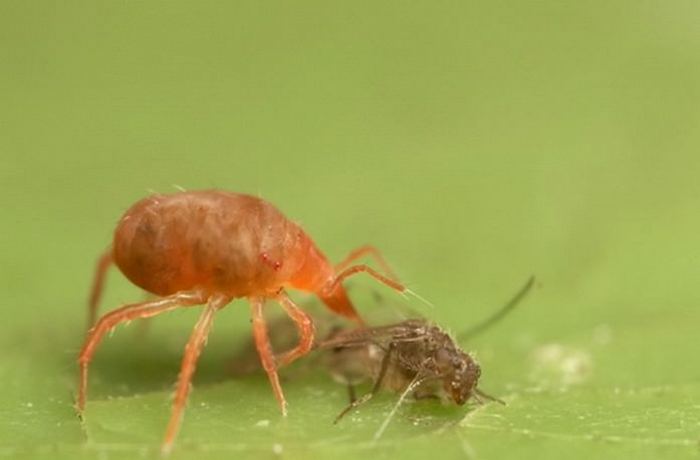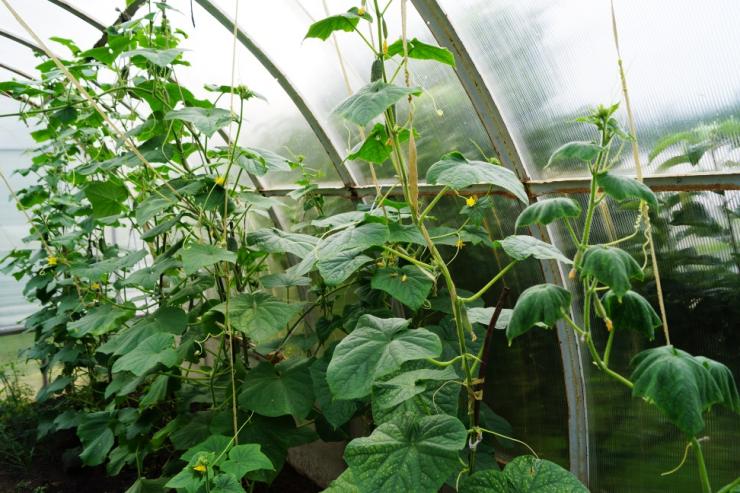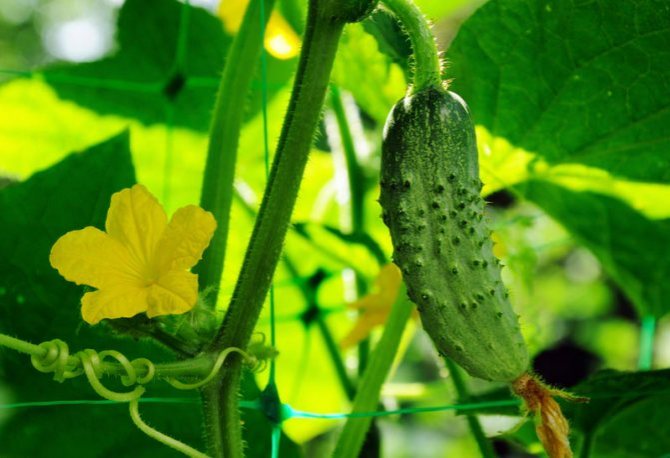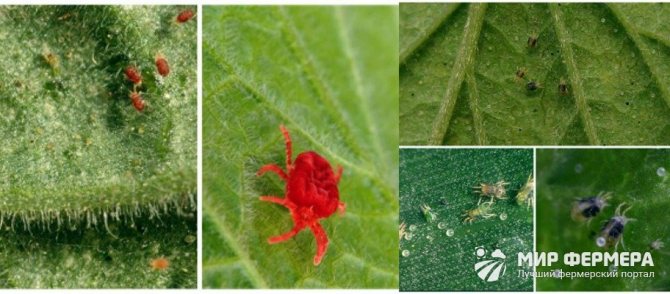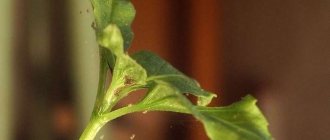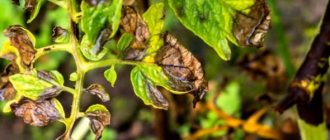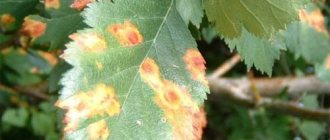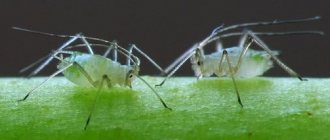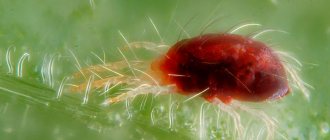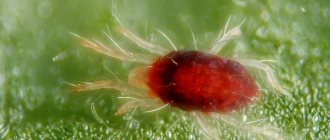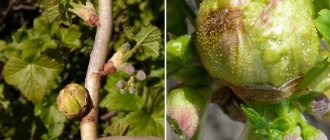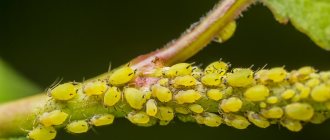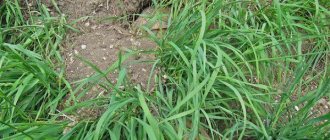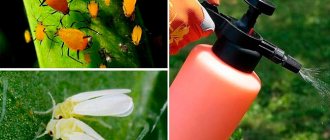The cucumber spider mite is the smallest insect that can cause great damage to cucumber beds in the greenhouse and in the garden. With a massive defeat of cucumber bushes, they quickly turn yellow and dry out, ending the growing season prematurely.
Getting rid of such a pest is not easy, as it quickly becomes accustomed to chemicals. Therefore, in the fight against it, drugs should be alternated and other control measures should be taken, which will be given attention today.

- Who is a spider mite, where does it come from on cucumbers
- What means will help rid cucumbers of spider mites Biopreparations
- Folk and improvised remedies for spider mites on cucumbers
- Chemicals
- Prevention in the greenhouse
The danger of the parasite for cucumbers
The arthropod feeds on the cell sap of the garden culture. Its salivary glands produce enzymes that destroy chloroplasts. Depending on the "food" preferences, there are different types of mites:
- polyphages are not picky about their diet;
- oligophages - prefer only certain species;
- monophages are dangerous for one particular culture.
This type of mite causes many plant diseases - for example, gray rot. It is an infection that kills leaves and fruits. In neglected areas, even the stems die off. Diseased shoots lose turgor, photosynthesis stops in them. At high air humidity, the ground part is overgrown with fungal organisms, and the spores are spread by the wind to neighboring areas, infecting other susceptible crops.
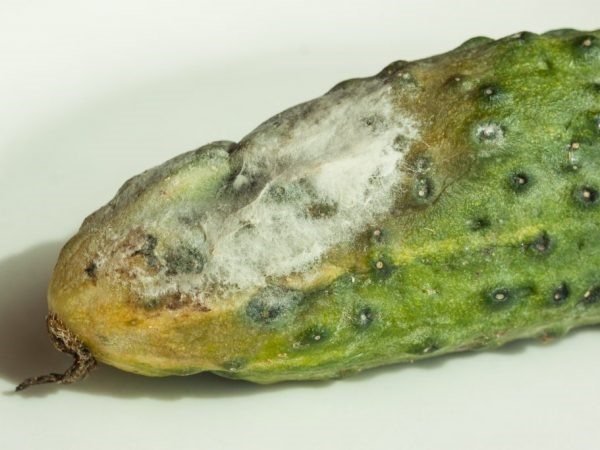

Gray rot fruit
Attention! Spider mites are not dangerous to humans. The only thing to be afraid of is contact with drugs that are used to treat plants.
They can be poisonous.
When an arthropod is affected, the bush stops growing and withers. If you do not take action, after 20 days of the week the plant dies.
If the spider mite is not removed from the garden, crops that are planned to be grown in the same area next year may suffer. When leaf fall begins, many fertilized females plunge into the soil and enter diapause mode. This is the ability to endure adverse external conditions. The body "turns on" the economy mode: the animal hardly moves, does not eat, and consumes less oxygen.


The female tick survives in the soil even in severe frosts
If the daylight hours are less than 14 hours, development is saved only in winter females of the parasite. They can withstand temperatures down to -28 ° C. When spring comes and the air warms up to 12 ° C, the parasites come out of the soil. First, they occupy weeds - for example, plantain. By the middle of summer, a new generation of the pest moves to cucumbers, where it continues its development and reproduction.
Professional advice


The spider mite hibernates in the upper soil layer and in the spring moves to weeds, developing on them, and then switching to cucumbers. Experienced gardeners advise planting a lawn around the plants to reduce the frequency of weeding and weed growth.
If you find infected vegetables, spray them every 5-15 days (depending on the spread of the tick and the period of crop development).
Experienced gardeners also praise the planting of the phytoseiulus tick. Leaves with individuals of this species are placed under the plant, after which the predator begins to hunt. Carnivorous mites are sold in specialized garden stores.
If these methods do not help, gardeners turn to chemicals - acaricides. The main thing is to carefully follow the instructions for their use and observe precautions.
Difficulties in dealing with a tick
It is very difficult to get rid of a spider mite, as evidenced by the numerous comments of summer residents. Gardeners complain: we are fighting insects by all possible methods, but no results are visible. No wonder: the enemy is very cunning, and in order to defeat him, you need to be patient and persistent. The most difficult thing is to notice the appearance of a pest in time. Every 2-3 days, carefully inspect all the plants in the greenhouse, look under each leaf and check for cobwebs or reddish insects.
In order for the fight against spider mites to be successful, you need to know all the tricks that help the insect to protect itself from poisons and other ways of harmful effects.
What qualities of this species help him to endure all the dangers? Nature has rewarded ticks:
- high fertility - you destroyed adult insects, but they were replaced by a generation hundreds of times larger in number;
- good adaptation to poisons and toxins;
- the ability to weave a web that protects insects from the spray of a poisonous solution.
Considering all the features of the insect, you will understand that you need to deal with the pest seriously. When using chemicals, do not exceed the concentration indicated in the instructions, but also do not make it too weak. If you are afraid of poisons, it is better to completely abandon chemicals than to poison half of the parasites and remove a species that is immune to toxins. Do not use the same insecticide you like: insects are already ready for a new poisonous attack, have developed immunity to poison - and you deceive them, spray them with a new agent for which the parasites are not yet ready.


General processing rules
Despite the fact that all of these drugs are different in composition, danger and method of application, there are general rules for processing cucumbers from spider mites.
The main thing is not to spray during the day, especially in sunny weather, otherwise the plant may get burned. It is better to process cucumbers early in the morning (before 10 o'clock) and in the evening (after 18).
Not all means can be used during the flowering period of cucumbers., as you can scare away insects pollinating it.
After processing with biological products, the fruits can be eaten in 2-3 days, with acaricides - in a month.
Parasite control methods
In order to say goodbye to parasites forever, use several simple folk methods, and then no insects will settle on cucumbers:
- Put about 15 g of onion in a jar and pour 1 liter of water into it. Let it sit for one night, after which you can water and spray your plants.
- The same can be done with dandelions. Mix about 20-30 g of this plant with warm water, and after two hours you can start watering.
- Make a garlic tincture. Rub it, put it in a bowl and pour water into it. Remove this infusion in a dark place for about 7 days.
- A pair of turpentine under cucumbers is also good at destroying the pest.
Difficulties in dealing with a tick in a greenhouse
The fight against the pest in question is complicated by the following factors:
• ticks not exceeding 1 mm are difficult to detect with the naked eye; • extremely fast reproduction - hundreds of individuals from one female; • fast adaptation of ticks to one poison; • the need for multiple processing; • cobweb, entwining plants, protects pests from the effects of poisons; • it is necessary to use highly concentrated solutions,harmful to human health.
How to protect your greenhouse from spider mites?
In the fight against this tiny but very dangerous pest, prevention is of great importance. Experienced farmers advise:
1. Thoroughly clean the greenhouse from organic residues, dig well or completely replace the top layer of the soil, disinfect it with bleach or sulfur sticks. 2. Clear the greenhouse beds from weeds even before planting cucumbers. 3. Change crops in the greenhouse: the first year - cucumbers, the second - tomatoes. 4. Do not thicken the planting to make it difficult for ticks to migrate from bush to bush. Planting cereal crops in the aisles will also help in this.


The best measure to combat spider mites is to increase the air humidity in the greenhouse to 80%
5. Increase humidity up to 80-85%. Ticks can hardly endure such conditions, but cucumbers like such a "bathhouse". 6. Regularly inspect the back of the cucumber leaves and immediately remove the affected ones, followed by burning. 7. Water and loosen the soil regularly. 8. Having found the place of localization of spider mites, do not wait until they get over to the cucumbers. It is necessary to quickly carry out the treatment with ancaricides or suitable biologics.
Acaricides - chemical protection of cucumbers
Agronomists have long been occupied with the issue of combating this insatiable pest. Specially developed drugs - acaricides - turned out to be an effective solution. The most famous: Aktellik, Bi-58, Bitoxibacillin, FToverm, Vermitic, Aktofit, Plan-Plin, Etisso, colloidal sulfur. The prepared solution should be sprayed with cucumber leaves at intervals of 10-15 days. If the infection is strong, more often. A shorter interval between treatments is also required at high air temperatures.
The destructive effect of acaricides is directed not only at ticks, eggs are also destroyed after repeated exposure
It is important to take into account that the pest quickly gets used to one type of toxic substance, therefore, acaricides must be alternated. Processing should be done in the evening, otherwise the solution will quickly evaporate under the scorching sun, reducing its effectiveness


An absolutely safe measure to combat spider mites in a greenhouse is to colonize phytoseilus. This mite is the worst enemy of the small cucumber pest. It is better to check in every three weeks.
Plants-acaricides from ticks on cucumbers
At the initial stage of infection of cucumbers in a greenhouse with a spider mite, you can try to cook the poison yourself. Many plants contain substances that are toxic to ticks. A self-prepared product will not harm either the cucumbers or the greenhouse owner.
• Aconite nose • Cow parsnip • Common Datura • Creeping bitterweed • Oriental goat's rue • Wormwood carpezium • Onion (husk) • Alder • Pyrethrum (red and pink) • Blue blue • Potato or tomato tops
For 1 liter of water, take 5-100 g of grass or roots of the listed plants and infuse for 12 to 24 hours. Before spraying, the cucumbers are diluted with water.
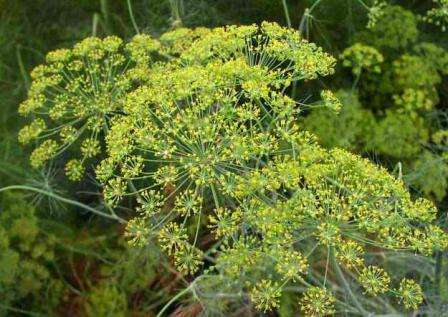

Dill attracts lovers of spider mites - ladybugs
Advice! Plant dill around the edges of the greenhouse. Its bloom attracts ladybirds like a magnet. When they flock to the greenhouse, insects are happy to feast on both ticks and aphids.
If you have spider mites on cucumbers in a greenhouse, you now know the measures to combat high efficiency. In case of severe damage, immediately run to the store for proven acaricides. If the colonization of pests is not massive, try folk methods. To protect the greenhouse from the invasion of spider mites in the future, carefully remove all residues, dig or disinfect the soil, water the cucumbers in time and loosen the soil under them, maintain high humidity. Plant dill around the perimeter. Do not hope that the ticks will go away on their own - they are too fond of cucumber juice.
Watch the video: Spider mite on cucumbers - how to detect and defeat it
Symptoms of the disease
The mite appears and begins to multiply exclusively in an environment with high temperatures and increased dry air. For the winter, the pest climbs into dry leaves, topsoil, manure and greenhouses, especially loves to hide in the corners.
What signs indicate the presence of insects and how can they be recognized? The symptoms of the appearance of a dangerous enemy of cucumbers are as follows:
- the appearance of light dots on the back of the sheet;
- slowing down the growth of culture;
- yellowing of the leaves.
The presence of at least one sign should alert the gardener. Lost time will cost the plants their lives, so you need to fight right away.
Spider mite development cycle
Insects settle in comfortable conditions for them, mainly on the lower part of the plant leaf, but then they can occupy large areas of culture. A spider mite can be recognized by the traces of its vital activity - marks on the leaves, small light dots.
Insects hibernate on plant debris, weeds, in the cracks of the greenhouse roof. After wintering at temperatures above 10–12 ° C, ticks begin to lay eggs on the underside of leaves of weeds and vegetable plants. Within a week, larvae appear from them, which settle on the underside of the leaves, feeding on plant sap.
The first signs of its presence are lightening points on the surface of the sheet. When the population of the tick increases, these arachnids form spider webs.
At first, these are small settlements of pests, but soon mites can fill the entire greenhouse, since they multiply quickly enough. Already a week after appearing on one plant, spider mites can be found not only in the footsteps, but also in a live form, crawling along the leaves.
After a while, a cobweb appears, in which young and rapidly developing colonies are located.
It is worth noting that female spider mites are very active, and after 3-4 days they will lay eggs, up to 400 each. In a year, development cycles can be up to 10-12, this corresponds to a suitable climate of 23-33 ° C and an average humidity in the greenhouse.
Resistant varieties
Another way to avoid spider mites is to grow a resistant strain. The most interesting of them are as follows.
Fontanelle
An early ripe variety, fruiting occurs 49–52 days after germination. Does not have bitterness, the fruits reach 8-10 cm.
Goosebump F1
A hybrid with short fruits about 10–12 cm long. It is considered early ripening, it takes 43–49 days from germination. Designed for growing in any conditions, disease resistant.
Well done F1
The hybrid is early ripening, from germination to fruit formation - 35–38 days. In the knot, from 1 to 3 ovaries are formed. In length, the fruit reaches 11-13 cm with a weight of about 120-150 g. It has a dark green color with light stripes on the tops, white thorns. Resistant to most common cucumber diseases. Ideal for planting in latitudes with unstable environmental conditions.
"Athlete F1"
The variety belongs to mixed flowering cucumbers, used for growing in greenhouses and on the southern side of the windowsill. The plant forms a trunk of about 3 m, so the greenhouse must be high. Before fruiting, 50–55 days pass from seedlings. The fruits are colored in light stripes.
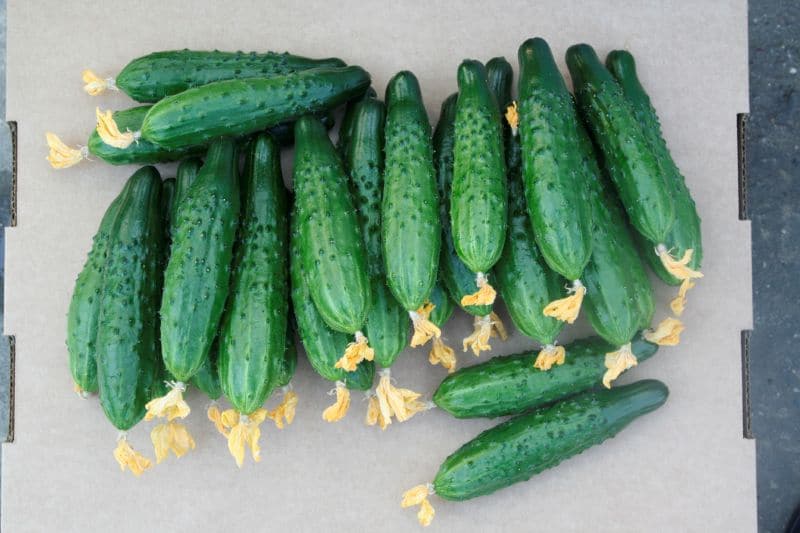

"Five Stars F1"
Ultra-early hybrid, from germination to fruiting - 40–42 days. Suitable for planting in all conditions. Fruits 12-13 cm long and weighing 110-120 g.
Measures to combat spider mites on cucumbers
How to deal with spider mites on cucumbers? In this case, the most important role is played by preventive measures carried out immediately after the end of the greenhouse harvest:
- do a general cleaning in the greenhouse, during which you remove all the remains of tops and weeds from it (it is better to burn them). It will also not be superfluous to remove the top (from 3 to 5 centimeters) layer of soil, since mites mainly accumulate in it.
- do not neglect thorough disinfection of all internal surfaces of the greenhouse, including garden containers and equipment. To do this, dilute 400 grams of bleach in 10 liters of water and let the mixture stand for 2-4 hours. Pour the upper transparent layer of liquid into a spray bottle and thoroughly moisten all parts of the greenhouse where mites can hide. The leftover sediment can be used to coat the lads in greenhouses. For such treatments, you can take caustic soda (from 300 to 500 grams of water for the same volume of water).
- start military operations against spider mites on cucumbers when the first signs of being hit by this pest appear. First things first, carefully pluck and remove all severely affected individual leaves from the greenhouse and apply them to the fire (in extreme cases, bury them deeply).
- since this pest spreads over the site on garden tools, clothes and seedlings, it makes sense to start all summer cottage work from areas unaffected by the tick. Around the beds of cucumbers and other crops mentioned above, regularly weed out the weeds on which he loves to live and reproduce.
- treat the plants from a spray bottle with onion peel infusion (pour in 10 liters of water at a temperature of about 40 degrees into 150-200 grams of peel and let it brew for 10 to 15 hours and, without diluting with water, spray the diseased herbs). For the solution to stick better to the leaves, it is recommended to add 10 to 15 grams of laundry soap for each liter.
- if the onion peel did not have the desired effect, then you can resort to using the biological product Aktofita 0.2% (according to the instructions).
The modest size does not prevent the spider mite from quickly crawling over very decent distances, which is why it is so important to timely detect infected cucumber bushes and immediately spray abundantly with natural or store-bought insecticide. Moreover, the treatment should cover not only the plants themselves, but also all the nooks and crannies in the greenhouse.
Prevention measures
Preventive measures include:
- deep digging of the soil after the last harvest;
- disinfection of the supports on which the plants are tied;
- destruction of all plant residues;
- avoidance of thickening of plantings;
- planting calendula, dill, marigolds and other fragrant plants next to cucumbers;


Fragrant plants to some extent repel pests
- timely burning of dead leaves.
Reasons for the appearance of a spider mite on cucumbers in a greenhouse
When a spider mite gets on a plant, it is able to completely destroy it in 7-10 days. Spraying cucumbers with poisons may not bring the expected result, since the insect braids it with a dense web and the poison may have little effect on the problem area. Therefore, you need to use effective measures to combat the pest insect.
A spider mite is a small insect belonging to the genus of arachnids, a photo of which is in the article. They reproduce especially intensively in summer, when hot and dry weather sets in. Under unfavorable living conditions, the tick moves to secluded places of the greenhouse and hides until better times. They can freely move from one greenhouse or greenhouse to the next, especially if the buildings are located nearby. The spider mite can travel long distances, moving on the cobweb in gusts of wind.
The parasite, getting on the cucumber plant, begins to weave on it a dense, reliable protection from the cobweb, feeds on the juice, sucking out all the contents completely. The tick will parasitize on the cucumber until its complete death. In addition, spider mites carry diseases such as gray mold bacteria.When cold weather sets in, they stop eating and hide in foliage or other secluded places in a greenhouse or greenhouse.
Signs of spider mite infection of cucumbers are as follows:
- white dots appear along the vein of the leaf;
- dots are colored yellow;
- gradually the tick braids the plant with cobwebs;
- leaves and fruits are modified.
Over time, the plant dies, and insects accumulate in large quantities on its surface. If the farmer discovers the defeat in the late stages, it is no longer possible to save the crop. Experienced growers already know well what a tick looks like. Therefore, in the spring, when the cucumbers in the greenhouse are just beginning to grow, gardeners check each leaf. In this early period, females are light in color and are clearly visible from the back of the leaf.
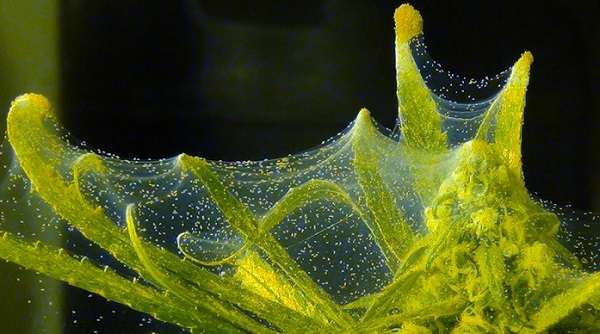

Spider mites on cucumbers in a greenhouse can kill plants in a matter of days
Description
Spider mites are a very common pest that occurs on vegetables, including cucumbers, eggplants, peppers, and tomatoes. It belongs to the class of arachnids, so it is difficult to call it an insect and will withstand treatment against simple midges. Small and almost invisible at first glance, the spider mite is able to completely destroy the plant. Its appearance is characteristic: the color is red, yellow or orange.
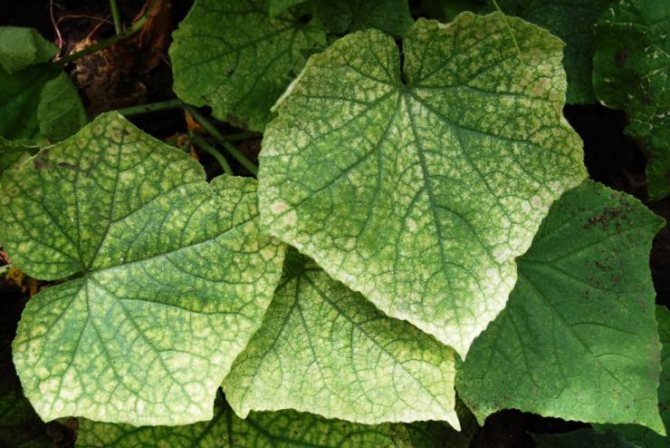

The body of a spider mite is small and has a rounded shape. There are small bristles on the body that trap an air bubble around the tick when it rains. This creates additional complexity when destroyed with water. The pest lives on the back of the leaves, so it is difficult to notice it. In the process of life, it feeds on plant sap, so after some time you can see whitish spots on the outside of the leaf.
Favorable for the development of larvae and active reproduction is a temperature above 15 degrees. At this temperature, the larva develops within 2 weeks. But if there is dry hot weather with a temperature of +30 degrees, then the embryo from an egg into an adult can develop in 2-3 days. With the onset of cold weather, the spider mite ceases to lead an active lifestyle and goes down to find a place to hibernate. In greenhouses, this is the top layer of the earth, places under leaves and dried plants.
There are many types of spider mites, but the most common are the following:
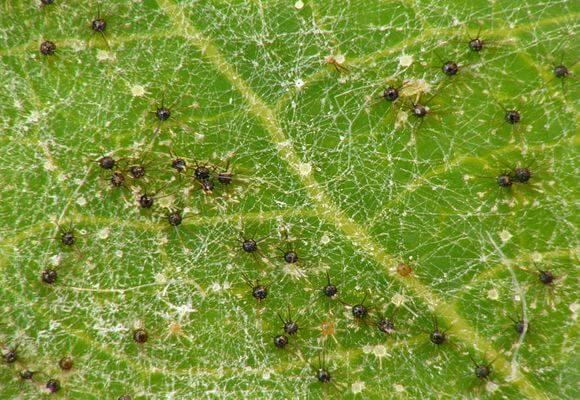

How to fight
Cucumber plants should be periodically inspected for insects. Any disease is easier to prevent than to treat it later. This also applies to insects.
If, upon examination, several leaves with signs of insects were found, then it is necessary to urgently begin to combat them. At the initial stage, when single sheets are affected, they must be urgently torn off and destroyed. At this stage, you can get by with folk remedies, but they are sometimes not as effective. When using biological drugs, their effect can not be seen immediately. Perhaps the best option would be insecticides - chemicals used to kill insect pests, their eggs and larvae. Some of them are effective against herbivorous mites.
There are many ways to combat spider mites, some of them are more effective, others less. What is right for you - the choice is yours. And I will briefly tell you what you can use in such a situation.
Biological preparations
- Aktofid - the main advantage of the drug is its high efficiency against spider mites on cucumbers. It degrades quickly and is not addictive, which means it can be used repeatedly. Effective in cool and hot weather. Its relatively low price will be a plus.
- Bitoxibacillin is an insecticidal drug based on the activity of certain types of bacteria.The action of the drug is aimed at the digestive system and the insect reproduction system. As a result, the fertility of pests and the viability of the larvae are reduced. The effect of the application occurs from the first to the tenth day of using the drug. After a week, you can see the mass death of pests.
The only drawback of these preparations is a short shelf life, only 2 months at a temperature of + 2º (due to microorganisms). Experienced gardeners recommend using both of these funds at the same time, adding to them a set of Brexil-Combi trace elements (15 g per bucket of water).
Ripe cucumbers are harvested before processing. Water is poured into the spray tank and all 3 drugs are added. They are treated with a solution from the bottom up (remember that insects are on the underside of the sheet). Processing is carried out in the evening.
- Phytoderm is a biological insecticide, a drug harmless to humans, as it is created on the basis of soil microorganisms. Not addictive to insects. After processing, in 2-3 days you can harvest. You can buy it at specialized stores. Before use, you must read the instructions for use.
Signs of defeat
It is necessary to recognize the invasion of pests as early as possible, the success of the fight against them directly depends on this. Appearing on one leaf, in a week, ticks can fill all plantings.
At the initial stage of damage to plants, according to their appearance, it can be assumed that the seedlings are affected by a fungal disease. But it soon becomes clear that it was spider mites that settled on cucumbers.
Signs of the appearance of a spider mite on cucumbers:
- On the back of the cucumber leaves, small dots of a silvery, white or yellowish color appear, gradually merging into stripes that resemble stains on marble.
- The light cobweb is visible first on the leaves, over time - on the petioles and internodes.
- Plexuses of thin threads appear among the greenery, along which ticks move between shoots.
- Tiny animals can be seen through a magnifying glass.
Over time, spider pests move from the lower tiers to the upper ones. Shoots turn yellow, wither and die. Sucking sap from the leaves, pests deprive them of chlorophyll, and, consequently, the possibility of photosynthesis.
Cucumbers weaken, grow poorly and can no longer withstand the attacks of other pests. In addition, such bushes often develop gray rot. The complete death of plantings can occur within 2 weeks after the first appearance of a spider mite on cucumbers.
For information on how to deal with spider mites on cucumbers, see the next video.
Effective pest control measures are difficult as spider mites reproduce quickly and even develop immunity to chemicals.
And in some cases it is difficult to identify it, a small insect settles on the underside of the leaf and is well camouflaged.
Preventing a tick attack is easier than dealing with the consequences of a tick attack.
- Do not forget about the need to dig the soil in the fall and spring after the snow melts.
- And it is also necessary to destroy the remains of plants, especially those affected. Experienced summer residents are advised to immediately burn dried bushes.
That's all. New articles on growing plants, and to help the gardener are yet to come. How do you treat this disease? I look forward to your comments.
See you in new articles.
In order to prevent the cucumber beds from being captured by this pest, you should follow the rules, thanks to which the risk of spider mites appearing on cucumbers will be minimal:
- If cucumbers were already grown on this site last year, then in order to grow a good harvest of this vegetable this year, you should choose another place.
- It scares away spider mites well - dill. If you plant this greenery around the perimeter of a cucumber area, then most likely arthropods will not penetrate such a hedge.
- Attracting natural enemies of this pest to the area where cucumbers are grown is the best prevention of damage to plants by this pest. The most dangerous enemy for the spider mite is the phytoseiulus mite. This "biological weapon" can be purchased in specialized stores that sell goods for the garden and vegetable garden. Phytoseiulus can effectively fight the pest at an early stage of the cucumber bush infestation by a spider mite. For prevention, the use of phytoseiuls is also effective, but this tick dies without food, therefore, for a preventive purpose, this "soldier" should be released periodically to the site.
- One of the main preventive measures is the daily inspection of plants for the presence of a pest. Due to its microscopic size, it can be very difficult to detect a small amount of this arachnid, but if the cucumber area is not large, then a daily inspection of the inner surface of the leaf will allow you to detect the pest at an early stage of plant damage.
Spider mites on cucumbers - signs of infection, folk methods of struggle, treatment and prevention!
Good afternoon, dear readers.


In this article, you will learn about the signs of a spider mite infestation. What conditions are favorable for infection. How to treat a disease using traditional, proven methods. How to treat the affected bushes in the greenhouse and in the open field.
What are the methods of preventing the disease. And what varieties are best to plant. What rules must be followed to get a good harvest. Great practical article!
Last time I told you why the ovaries on cucumbers turn yellow. Not every summer resident knows what a spider mite is on cucumbers, how to deal with this pest and prevent problems. This is a big problem many gardeners are constantly struggling with.
Sometimes the fight against the spider mite is delayed, and the greenhouse does not save from it. This article will tell you how to prevent infection and get rid of the misfortune.
An infected plant can be recognized by the following:
- traces of "bites" are visible - small light dots;
- on the back of a cucumber leaf, skins thrown off after molting are noticeable, and if you look closely, then the spider mites themselves;
- there are sticky shiny spots on the leaves;
- a thin web is visible.
The main "wake-up call", which is the easiest to detect: young cucumber leaves are not gaining their required size. The length of the internodes is significantly reduced. As a result, the shoot closer to the point of growth begins to curl, at the end a "bunch" of small underdeveloped leaves is visible.
The cucumber, trying to fight for life, begins to intensively pinch. On the stepsons, traces of defeat appear in a day. The affected areas quickly turn yellow and die off. The situation is aggravated by fungal infections, with which the weakened immunity of the cucumber is not able to fight. In this state, even after intensive treatments, the plant will no longer be able to recover and begin to bear fruit. Having "finished" the shoot, spider mites scatter to the neighboring ones.
Greenhouse pest control methods
The best way to stop spider mites from breeding in a greenhouse is to increase the air humidity to 80-85%. This will not bring any harm to cucumbers, because the conditions of the "bath" are very suitable for them. But a tick humidity above 60% can paralyze.
In order to finally rid the greenhouse of the spider mite, you need to take more radical measures. We are talking, of course, about the use of pesticides. Yes, not every farmer is ready to do this, but sometimes you have to choose between a crop with a share of harmful substances and its complete absence.
To combat spider mites, modern industry offers a special group of drugs called acaricides. You can also use insectoacaricides, the action of which is additionally directed at other pests. But insecticides will not give the desired effect.
The fastest way to get rid of a spider mite is:
• Akarin, • Karbofos, • Apollo, • Fitoferm, • Bitoxibacillin, • Iskra-Bio.
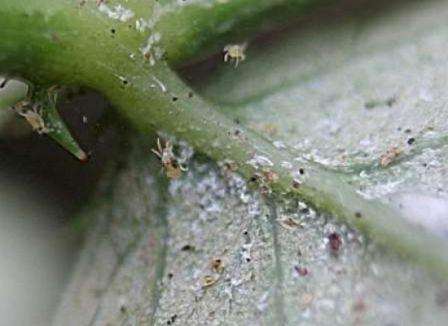

Note the following tips for spraying cucumbers in your greenhouse:
• It is best to do this on a not very hot evening, so that the drug has time to affect the pests before evaporating from the surface of the plants. • Processing cucumbers alone is usually not enough. If it is very hot in the greenhouse, treatment should be carried out at weekly intervals. • Do not exceed the dosage of the drug when spraying
• Precautions when handling cucumbers - body and breathing protection - are essential.
The biological method of combating spider mites implies the settling of pests in the greenhouse that can destroy it. The sworn enemy of the arachnid in question is the phytoseilus mite. Check-in must be carried out every three weeks.
Folk ways to combat spider mites
Traditional methods are always less effective, but safer than acaricides. If the defeat of cucumbers is not too large-scale, then at the beginning it is better to do without chemistry.
Spider mites can be scared away by:
• Marigolds. You need to collect half a bucket of flowers and fill them with warm water for two days. A quarter of a bar of laundry soap should be added to the resulting infusion. The anti-mite agent is ready to use. • Potato tops. You need to collect one and a half kilograms of fresh tops and pour a bucket of warm water for only 4-5 hours. By wetting cucumber leaves with this composition, you can say goodbye not only to spider mites, but also to caterpillars and aphids. • Tomato tops. In this case, the tops (4 kg) should not only be soaked in a bucket of water, but also boiled for half an hour. At the end, add ¼ household bar. soap. Before processing cucumbers, the infusion is diluted ½.
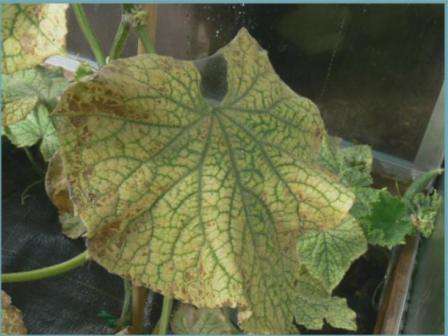

A spider mite wraps around cucumbers in a greenhouse with a barely noticeable cobweb
Preventive measures: how to protect the greenhouse from spider mites?
The given folk methods of dealing with this arachnid can be safely used for prevention purposes. It is better not to use chemical preparations once again. The greenhouse with cucumbers should always be humid enough. After harvesting, all plant residues should be removed. The topsoil (10-20 cm) must be replaced every year. The soil removed from the greenhouse can be used for other crops. Every year, it is imperative to disinfect the greenhouse, cultivating both the land and the structure.
It is important not to miss a single gap.
One of the most popular methods of preventive treatment of greenhouses is the use of sulfuric bombs. So you can rid the greenhouse of all types of dangerous parasites: ticks, bacteria, viruses and fungi. If in the past season the spider mite bothered you greatly, then the recommended dosage of sulfur should be increased by 3-4 times. When using sulfur bombs, the temperature in the greenhouse should be at the level of 10-15 ° C.


Now you probably understand the threat posed by spider mites on cucumbers in a greenhouse. The measures of struggle in this case can be different, and they depend on the scale of the "tragedy". With a small lesion, you can use folk remedies, but with extensive distribution, you cannot do without the use of a biological or chemical method for removing the pest. However, nothing better than prevention has yet been invented!
Watch a video about spider mite control measures
Helpers
Since ancient times, there are plants that will contribute to the growth of another, and in this case, you can resort to the help of nature. For the preparation of broths, you can resort to a pharmacy that sells hundreds of different mixtures.
If you take dried dandelion flowers and pour boiling water over them, you can make a tincture in a shorter period. For 10 liters of water, you will need half a kilogram of dried flowers.
Another effective remedy is a tincture of half a kilogram of onion and one head of garlic.
It is necessary to apply these funds by drip, but you should avoid midday, or when the sun is very hot. Otherwise, the plant may burn. In addition, sunlight can affect active substances, reducing their effectiveness to zero.
Ways to deal with spider mites


If infected cucumber leaves are found, they must be torn off and burned. This method of control does not give a complete guarantee that the pest will not appear on other leaves or bushes of cucumbers, however, this must be done. If the whole plant is affected, then it must be uprooted and also burned. The soil under it must be watered with a weak solution of potassium permanganate.
With the early detection of a spider mite, when the cucumber leaves have not yet begun to wither, but there are already signs of the appearance of a pest, you can wipe the leaves with a napkin dipped in a solution of hydrogen peroxide, turpentine or ammonia.


The best way to combat spider mites is spraying with biologically active drugs of systemic exposure. Three or four treatments are enough to get rid of these pests completely. It is necessary to use such protective equipment in strict accordance with the instructions.
Before spraying, it is imperative to remove all the cobwebs from the leaves, if they have not wilted yet. Dry leaves should be torn off and burned, it is pointless to treat them.
If the tick on cucumbers has become too prolific, then you cannot do without chemicals. Do not forget that these are toxic substances, they harm people. You can only use them at least.

